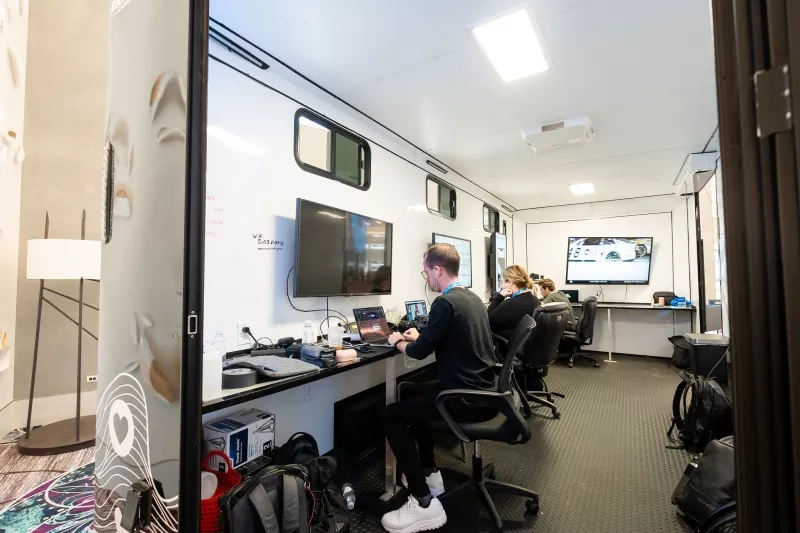Public relations events, or PR events, are an excellent way to “get the word out” about a brand or product. While PR events are certainly a small niche in the event industry, the global public relations market is worth more than $97 billion and is expected to surpass $129 billion by 2025.
If you’re just starting out in the PR event planning space or you’re looking for a step-by-step guide to help you organize one of these events, you’re in luck! In this blog, I’ll walk through the event planning strategies that work for PR events and offer a guide to help you get your PR ducks in a row.
What Is PR Event Planning?
Before we dive into PR event management strategies, let’s get on the same page about what PR event planning actually is.
PR event planning involves organizing and executing a public relations event that showcases a company, brand, product, service, or client in order to attract new customers. PR events can have many goals, including:
- Promoting brand recognition and gaining media attention
- Fostering a positive image of the entity being promoted
- Netting sponsors, investors, or other partnership opportunities
- Increasing product sales or growing a customer base
- Boosting sales at the time of product launches using product launch events
- Informing customers or clients about exciting new changes or products
- Assisting other teams in meeting broader company goals, such as quarterly sales or more diversified clientele
What Are the Key Elements to Consider When Planning a PR Event?
Not all PR events are created equal. Here are a few tips to help ensure your event doesn’t flop.
Know the “Who, What, and Why” of Your Event
Throughout the planning process, you must be very clear about what you’re promoting, to whom, and with what goals in mind. If you lose sight of any of these elements, there’s a good chance your event will suffer.
Without considering the who, what, and why of your event throughout your entire plan, you could lose consistency in messaging, confuse your audience, and do a disservice to your brand, product, or client.
Ensure You Can Achieve Measurable Results
When setting goals for your event, it’s critical to ensure they’re measurable. Why? It’s the only way to gauge the success of your event, and if you’re reporting to stakeholders or need to prove ROI for quarter-end or year-end quotas, you’ll need some hard data to prove your event was worth the cost and effort.
Include ESG in Your Planning
Environmental, social, and corporate governance (ESG) reporting might not be event planners’ bread and butter, but it’s a critical element to consider when planning PR events (or any event).
Companies are being held increasingly responsible for the climate impact of their business operations, and this includes events. Particularly when planning in-person events, depending on the scale and amount of travel required, PR event planners should consider how their events impact or conflict with their companies’ overall ESG goals.
Technology Is Your Friend
While PR events aren’t typically as large as trade shows or industry conventions, they can be just as complex and have even more riding on their success. Event technology truly is your friend when it comes to coordinating and executing PR events.
In fact, 59% of PR professionals believe technology will be key in driving the transformation of the public relations industry. When planning your events, no matter how small, don’t think you have to do it on your own.
14 PR Event Planning Steps
As promised, let’s dive into the steps you’ll need to take to organize your event. You can think of this list as a PR event planning template to help you craft a general plan for your event.
Once you’ve checked all these boxes and are ready to deep dive into the nitty-gritty aspects of your event, you can check out our more detailed PR event planning checklist.
Step 1: Review and Align Your Goals
As I mentioned before, establishing your event goals – and ensuring they’re measurable – is critical to the success of your event. Your event goals should not only include showcasing whatever you’re promoting but also meeting broader business goals.
What’s more, your event must align with any corporate policies, priorities, and messaging to ensure you stay on brand and set the right tone for your promotion.
When setting your goals, you’ll need to dig deeper than promoting your latest product. You’ll need a true benchmark for success, such as:
- X number of units sold during your event
- X units sold in the 10 days following your event
- X attendees at your event
- X new clients signed during or because of your event
- X number of times your event hashtag was used
Step 2: Identify Your Target Audience
If you fail to identify your target audience, your event is bound to fail. Your target audience is the sweet spot where interest in whatever you’re promoting, money to support or buy it, and willingness to participate in your event all align.
As you plan your event, consider your target audience and what they’d like to see at your event. How should you communicate with them to get them to attend? What’s most important to them when choosing to attend an event? What motivates them to spend money on a product or business like yours?
Step 3: Set a Reasonable Budget
Event budgeting is always tricky, but PR events are unique in that the majority of your budget will be spent on promotion tactics. This includes not only promoting the event to attendees but also attracting media coverage, renting a venue that will attract attention, and curating a guest list that might include paid appearances or speakers for high-profile guests.
With all of these considerations in mind, you’ll still need to budget for the typical event needs, including security and logistics, catering, transportation, and more. Depending on what activities you plan and where your event takes place, your budget will likely be higher than other types of events – even those with much larger attendance.
Step 4: Establish Your Timeline
Your event timeline will depend on many factors, including product launch date or other important dates, how quickly you can promote your event to prospective attendees, how far attendees will need to travel, how quickly you can get your budget approved, and any other factors that might dictate how quickly your event needs to get off the ground.
Once you’ve evaluated all the external factors impacting your timeline, consider how much time you and your team need to make the event a success. If you’re pressed for time, consider using event management software to help speed up some of your manual processes and keep your event on track.
Step 5: Choose Your Event Format
In-person and virtual and hybrid, oh my! There are several event formats to choose from these days, and while PR events have historically taken place primarily in person, that might not be the best format for your event.
Perhaps your target audience is widespread and is restricted in their business travel. Or, perhaps your company’s ESG policies would make a virtual PR event a more tactful option. Maybe you’re promoting a product or service that’s best showcased online.
Whatever the case may be, carefully consider your event format from the start, and don’t assume in-person is the best format simply because it’s what’s been done before.
Step 6: Find the Right Venue or Platform
If you’re planning an in-person event, venue sourcing is a critical step in the planning process. You’ll need a venue that can accommodate your target attendee count and that is interesting or lux enough to attract attendees and the media.
What’s more, you’ll need to ensure your venue’s values and practices align with the brand, product, or company your event is promoting. Going back to those ESG policies, consider whether your venue prioritizes accessibility, sustainability, diversity, equity, and inclusion.
If you’re taking your event online, you’ll need a virtual event platform that can meet all your needs, from a website and registration page to hosting the actual event.
Step 7: Outline the Attendee Experience
What activities will you plan for your event? How will attendees interact with your brand, product, etc.? Will you offer food and drinks?
Find out what appeals to your target audience and incorporate these elements into your event to entice them to come. Decide what perks and incentives you can offer, which keynote speakers make sense for your event, organize celebrity appearances, and consider adding a philanthropic element.
Step 8: Decide Whether to Partner with Sponsors
Event sponsorship can make or break a PR event. Partnering with sponsors offers a wide range of benefits, including offsetting the event costs with financial support, additional resources and channels for promotion, an expanded audience attracted by sponsors’ brands, mutual promotion across marketing channels, and so much more.
If you’ve decided to offer sponsorship opportunities for your event, carefully select which companies you’ll reach out to. You’ll want to be sure you both share a target audience and that your brands align well.
In addition, you’ll need to consider what sponsorships will look like. What sponsorship packages will you offer? What can your sponsors provide in addition to financial support? However your agreements look, be sure they’re mutually beneficial and in line with your event goals.
Step 9: Arrange Logistics to Streamline Everyone’s Experience
At this stage in the planning process, you’ll need to consider event logistics. Event coordination isn’t easy, and when you’re planning a PR event, there’s a lot to consider that’s difficult to control.
You’ll need to cover the typical logistical items, such as staff travel to and from the event, catering timelines and quantities, speaker transportation and prep, local transportation and possible room blocks for attendees, event security, etc.
Beyond all this, you might also need to coordinate elements like celebrity appearances, including travel and security to and from your event, and media coverage, which means having room for several media outlets to set up equipment without being in the way of your event.
Step 10: Formulate an Event Marketing Strategy
PR event marketing can include so many different tactics, from email campaigns to experiential marketing.
Will you create an event website? Send emails with an event marketing platform? Post on social media? Pay for advertising? The scale of your PR event, as well as your event’s format and target audience, should inform your event promotion strategy.
Want to explore all the PR event marketing possibilities? Check out our complete guide to event marketing!
Step 11: Create an Online Presence for Your PR Event
In this day and age, every event needs an online presence. Whether it’s a custom branded event website, a mobile event app, a hashtag circulating on social media, or a YouTube channel, your event should have a presence and a brand of its own.
This level of brand activation means reaching into as many corners of the web as possible using every channel at your disposal to get the word out and give your event a recognizable brand of its own.
Of course, the time and effort you’ll put into building your event’s online presence should depend on your budget, timeline, and scale of your event. If your target audience can be reached without using ten different platforms, so much the better!
Step 12: Be Prepared for Anything
If the pandemic taught us anything, it’s that something will always go wrong when event planning. Of course, it won’t always be something quite so devastating, but it’s important to have contingency plans in place.
The best way to be prepared is to have PR event management tech up your sleeve that helps you navigate every piece of your event so that if anything goes wrong, everything you need to make it right is already in front of you.
Step 13: Capitalize on Your Momentum
Don’t let a good event go to waste. The value of your event should outlive the event itself, and it can, as long as you formulate a follow-up strategy that makes the most of your success and the connections made during the event.
Reach out to media outlets to discuss your event and the goals it helped you achieve. Conduct interviews with attendees, including speakers and celebrity guests, to showcase testimonials from the event.
All of this can help reel in anyone who missed your event or is on the fence about providing financial support, and you can stir up interest in future PR events, improving your chances of getting media attention and important guest appearances in future.
Step 14: Evaluate Your Success for Future Events
Once your event has wrapped, it’s time to consider what worked and what didn’t. At this point, you’re getting into the event evaluation stage, and you’ll need event data to prove you’ve met your goals and achieved the desired ROI.
This is a critical step that can’t be missed. Regardless of whether you have sponsors or stakeholders to report to, it’s critical to measure your event’s success to determine whether your goals have been met or if further efforts are needed.
Especially when planning future events, you’ll need to prove that you stuck to your budget and used your event to achieve as many goals as possible if you’re hoping for approval for similar events in the future.
What Metrics Should Be Used to Evaluate the Success of a PR Event?
When it comes time to measure the success of your PR event, the metrics you use to evaluate your event will depend on your goals. In general, you can measure the success of a PR event using the following metrics:
- Attendance: The number of attendees present can help you determine the reach of your event.
- Media Coverage: If you’re aiming for broad coverage, the number of media outlets running stories about your event or the number of times your event is mentioned in the press can be useful metrics.
- Sales and Revenue: Your event’s impact on sales or revenue can be a straightforward metric to help you measure success.
- Social Media Engagement: The number of times your event’s hashtag is used; likes, shares, and comments on your posts; number of cross-posts by sponsors or celebrity guests; and many more criteria can be used to evaluate your event’s success.
- Attendee Feedback/Client Satisfaction: Post-event surveys and testimonials can be helpful in understanding the success of your event and what you could do better next time.
Ready to start planning your PR events? Get started with event planner software that’s by your side every step of the way!












